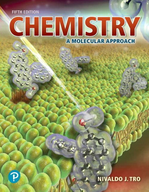?Carbon suboxide, \(\mathrm{C}_{3} \mathrm{O}_{2}\), is a linear molecule with the two
Chapter 24, Problem 93(choose chapter or problem)
Carbon suboxide, \(\mathrm{C}_{3} \mathrm{O}_{2}\), is a linear molecule with the two oxygen atoms at the end and double bonds between each carbon and oxygen atom.
a. Draw the Lewis structure for \(\mathrm{C}_{3} \mathrm{O}_{2}\).
b. State the type of hybridization of each carbon atom.
c. Calculate the heat of reaction for the reaction of carbon suboxide with water to form malonic acid \(\left(\mathrm{HO}_{2} \mathrm{CCH}_{2} \mathrm{CO}_{2} \mathrm{H}\right)\). Hint: Each end of malonic acid has a carbon double bonded to an oxygen and to a hydroxide.
Text Transcription:
C_3O_2
(HO_2CCH_2CO_2H)
Unfortunately, we don't have that question answered yet. But you can get it answered in just 5 hours by Logging in or Becoming a subscriber.
Becoming a subscriber
Or look for another answer
